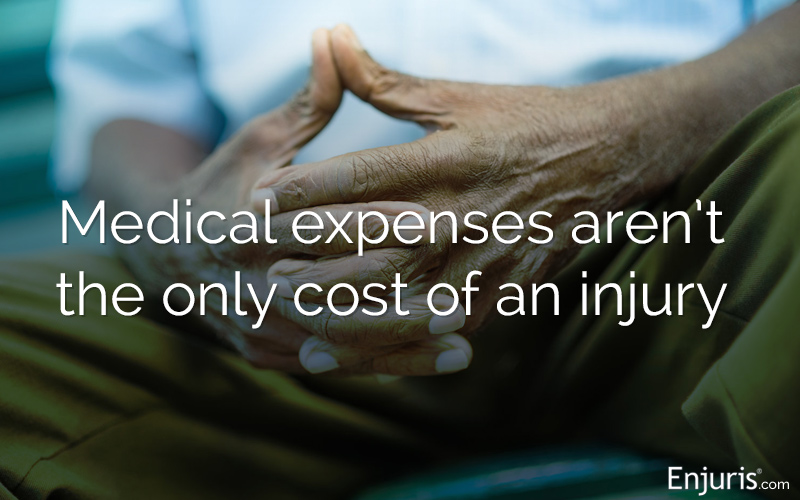How much can you recover for the physical and emotional stress caused by an injury?
A serious accident often leaves a survivor with more than just physical scars.
In South Carolina, you can receive compensation for the pain and suffering you experience as a result of an accident—but how do you put a price on something that’s subjective?
Economic vs. non-economic damages
In South Carolina, plaintiffs can recover both economic and non-economic damages:
- Economic damages are intended to compensate you for the monetary losses associated with your injuries.
- Non-economic damages are intended to compensate you for the non-monetary losses associated with your injury.
Here’s a breakdown of what’s included in each category:
| Economic damages | Non-economic damages |
|---|---|
|
|
As you can see, physical and mental pain and suffering damages are considered non-economic damages. To be more specific:
Pain and suffering is the legal term used to describe the physical and emotional stress caused by an injury.
In other words, an award for pain and suffering compensates the injured person for the physical discomfort and the emotional response to the sensation of pain caused by the injury itself.
Let’s look at an example:
As a result of her injuries, Erin incurred $500,000 in medical expenses. She also missed 2 months of work, during which time she would have earned $6,000. What’s more, Erin experienced 2 months of extreme physical pain and discomfort. She also became depressed, angry, and had trouble sleeping.
If Erin were to file a personal injury lawsuit, she could demand $506,000 in economic damages (medical expenses and lost wages), but she could also demand non-economic damages for her pain and suffering (2 months of extreme pain and discomfort, depression, anger, lack of sleep).
When are pain and suffering damages available in South Carolina?
You can request pain and suffering damages in most personal injury cases, including:
How much is my pain and suffering worth?
It’s hard to put a price tag on subjective pain and suffering, and there’s no specific formula for doing so.
As the South Carolina Supreme Court explained:
“Pain and suffering have no market price. They’re not capable of being accurately determined, and there’s no fixed rule or standard whereby damages for them can be measured. Hence the amount of damages to be awarded for pain and suffering must be left to the judgment of the jury, subject only to correction by the courts for abuse.”
Despite having no set formula to follow, courts generally consider the following factors when trying to determine the amount of pain and suffering damages to award:
- Type of injury
- Type of medication
- Length of recovery
- Permanency of injury
- Strength of evidence
- Likeability of the plaintiff
- Location of the court (jurors in certain counties are more or less likely to award pain and suffering damages)
What’s more, insurance companies and defense attorneys estimate a total case value by assigning pain and suffering damages a number (1 through 5) depending on the severity of the injury:
Pain and suffering damage caps
Though there’s, unfortunately, no limit to the amount of personal pain and suffering you can experience after an accident, South Carolina does place a cap on non-economic damages in certain cases:
- For malpractice claims, non-economic damages are capped at $350,000 per defendant, and there’s a $1.05 million overall cap for all defendants
- For claims against the government, all damages are capped at $300,000
What can I do to support my claim for pain and suffering damages?
Proving pain and suffering damages can be challenging. Unlike medical expenses, you can’t simply show the jury a bill for the amount owed.
The 3 most effective ways to support a pain and suffering claim include:
- Expert witnesses. Medical experts can testify as to whether pain generally exists for a particular injury, to what extent, and for how long.
- Lay witnesses. Lay witnesses, such as friends and family, can testify about the impact of the injury on your life.
- Medical records. Medical records, particularly doctors’ and nurses’ notes, will often contain information about your physical and mental state at the time of the appointment. For this reason, it’s important that you tell your doctor or nurse if you’re experiencing pain or any mental issues.
Additionally, it’s important that you keep track of the day-to-day impact of your injury in a post-accident pain journal.

Sample accident journal/diary to help you document the effect on your daily life
Download in PDF format
Do I need an attorney to recover pain and suffering damages?
You’re not required to hire an attorney to claim pain and suffering in your personal injury lawsuit. Nevertheless, an attorney can help gather the proper evidence to support your claim. What’s more, attorneys have experience explaining pain and suffering to juries in a way that helps the jury put an appropriate price tag on your pain and suffering.
If you need help locating an attorney in South Carolina, consider using our free online directory.
Once you’ve located an attorney, be sure to prepare for your meeting so you can get the most out of it.
See our guide Choosing a personal injury attorney.



